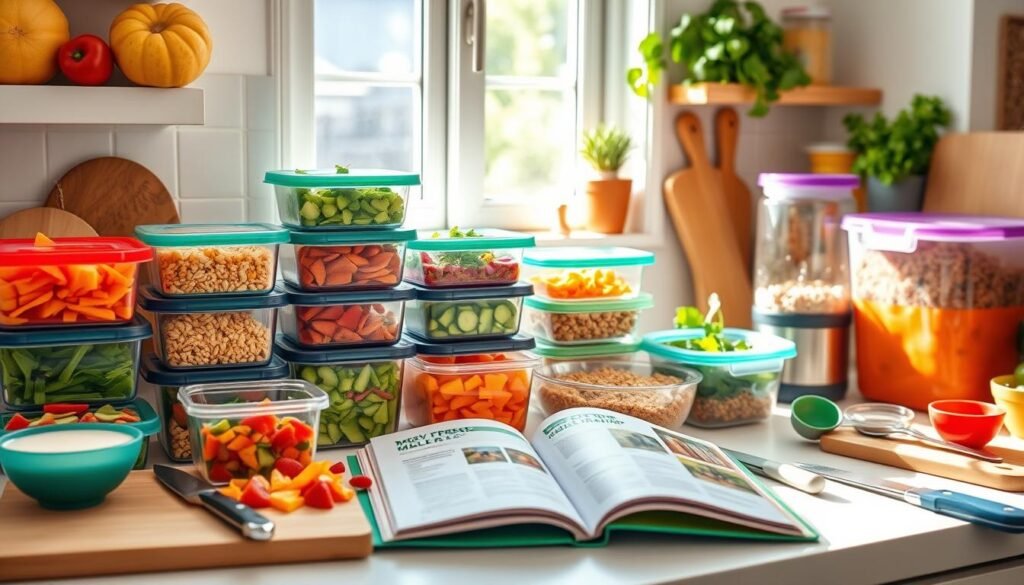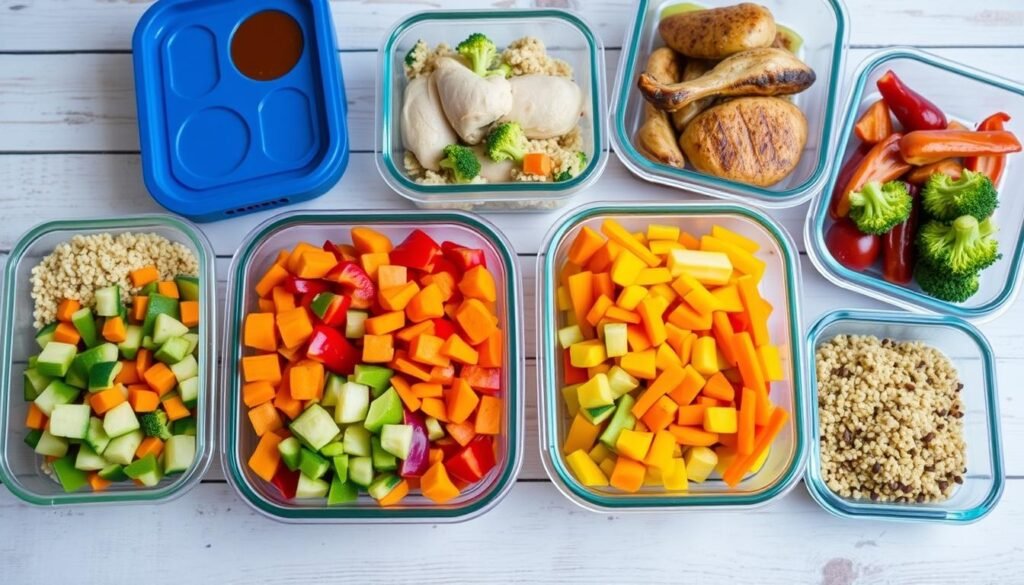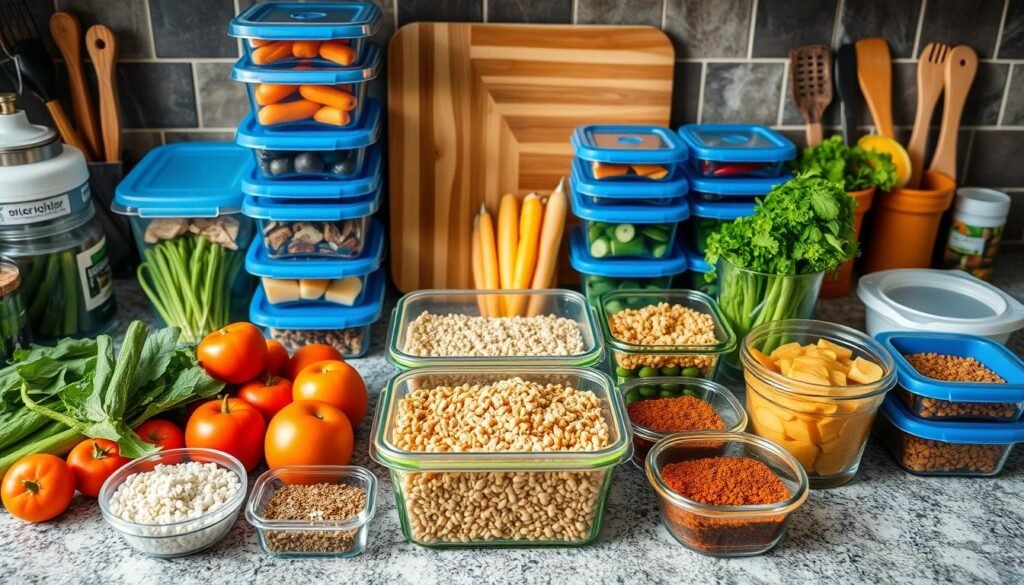Meal prepping can be a game-changer when it comes to maintaining a healthy lifestyle, saving time, and sticking to a budget. But where do you even begin? If you’re new to the world of meal prep, the process can feel overwhelming. Fear not, my fellow food-prepping enthusiasts – I’ve got the ultimate checklist to guide you through this transformative journey.
Have you ever wondered, “Can meal prepping really make that much of a difference in my life?” The answer might just surprise you. Join me as we dive into the world of meal planning and uncover the secrets to unlocking a healthier, more organized, and budget-friendly lifestyle. Get ready to wave goodbye to those last-minute takeout runs and hello to a newfound sense of control in the kitchen.
Key Takeaways
- Meal prepping can save you time, money, and help you maintain a healthy diet.
- Understand the benefits of meal prep, including time savings, cost-effectiveness, and improved eating habits.
- Learn the essential steps to get started with meal prep, from planning your meals to stocking up on the right supplies.
- Discover the best foods and techniques for successful meal prepping.
- Explore tips for storing and reheating your prepped meals to ensure maximum freshness and flavor.
Why Meal Prep?
Meal prepping is a game-changer for those seeking to streamline their lives and improve their overall well-being. This simple practice offers a trifecta of benefits: time-saving efficiency, cost-effective advantages, and healthier eating habits.
Time-Saving Benefits
By cooking once and enjoying multiple meals throughout the week, meal prepping eliminates the daily struggle of deciding what to eat and preparing a full meal from scratch. This can be a lifesaver for busy individuals or families who struggle to find time to cook every day, providing a convenient and efficient solution that frees up valuable time.
Cost-Effective Advantages
Meal prepping can also be a budget-friendly approach to managing your food expenses. When you plan your meals in advance and buy ingredients in bulk, you can reduce food waste and ensure you only purchase what you need. This not only saves you money on groceries but also helps you avoid the temptation of eating out, which is often more expensive.
Healthier Eating Habits
Perhaps the most significant benefit of meal prepping is its ability to promote healthier eating habits. When you prepare your own food, you have complete control over the ingredients and portion sizes, allowing you to make more nutritious choices. This can be particularly helpful for weight management, as meal prepping makes it easier to stick to your calorie or macronutrient goals and maintain a balanced diet.
“Meal prepping is a game-changer for those seeking to streamline their lives and improve their overall well-being.”
Whether you’re looking to save time, reduce food costs, or simply eat a more nutritious diet, the advantages of meal prepping are undeniable. By embracing this simple yet effective strategy, you can enjoy a time-saving, cost-effective, and healthier approach to your daily meals.
Getting Started with Meal Prep
Getting started with meal prepping can feel overwhelming, but it doesn’t have to be. The key is to start small and build up your routine gradually. By taking it step by step, you can easily incorporate meal prep into your lifestyle and reap the benefits of time-saving, cost-effective, and healthier eating habits.
One of the best ways to begin your meal prep journey is by packing up your leftovers from dinner one night and taking them for lunch the next day. This simple act helps you get comfortable with the concept of prepping meals in advance. Once you feel confident with that, you can move on to picking one recipe to prep for the week ahead.
Single recipe meal preps that provide your protein, grain, and vegetables all in one dish are a great place to start. This allows you to have a complete, balanced meal ready to go without much fuss. As you get more experienced, you can expand your meal prep repertoire to include multiple recipes and more complex dishes.

Remember, the most important thing is to start small and gradually build up your meal prep routine. Don’t try to tackle everything at once, as that can quickly become overwhelming. Take it one step at a time, and soon you’ll be a meal prep pro!
- Pack up leftovers from dinner for lunch the next day
- Choose one recipe to prep for the week ahead
- Opt for single recipe meal preps with protein, grain, and vegetables
- Expand your meal prep repertoire as you gain experience
- Start small and gradually build up your routine
| Meal Prep Tip | Benefit |
|---|---|
| Pack leftovers for lunch | Saves time and money |
| Choose single recipe meal preps | Provides a balanced, complete meal |
| Start small and build up gradually | Helps prevent overwhelm and ensure sustainability |
Meal Planning: The Foundation
Successful meal prepping starts with a solid meal plan. By assessing your schedule, taking inventory of your pantry, and choosing the right recipes, you can create a meal planning foundation that sets you up for success.
Assess Your Schedule
Before you start planning your meals, take a close look at your calendar and daily routine. Determine how many meals you’ll need to prepare each week, accounting for work, social events, and any other commitments. This will help you avoid over-planning or under-planning, ensuring you have the right amount of food prepped.
Inventory Your Pantry
Once you know how many meals you need to prepare, take a look at what you already have in your pantry and freezer. Making a note of the ingredients you have on hand will help you use up what you already own, saving you money and reducing food waste. Incorporate these staple items into your meal plan whenever possible.
Choose Meal Prep-Friendly Recipes
When selecting recipes for your meal plan, look for dishes that are well-suited for meal prepping. Recipes that involve batch cooking, such as stews, chilis, and casseroles, or those that allow for easy ingredient prep, like roasted vegetables or cooked grains, tend to work best for meal prepping.
“Meal planning is the foundation for successful meal prepping. By taking the time to assess your schedule, inventory your pantry, and choose the right recipes, you can create a meal plan that sets you up for success.”
By following these steps, you can build a solid meal planning foundation that will make your meal prepping process more efficient and effective. With a little bit of upfront work, you’ll be well on your way to enjoying the time-saving, cost-effective, and healthier benefits of meal prepping.
Essential Meal Prep Supplies
Meal prepping can be a game-changer for busy individuals, but it’s essential to have the right supplies to make the process seamless and efficient. From sturdy meal prep containers to versatile kitchen tools, investing in the right equipment can revolutionize your meal prep routine and help you achieve your health and fitness goals.
Containers for Storage
Choosing the right meal prep containers is crucial for maintaining food safety and preserving the freshness of your meals. Look for containers that are BPA-free, microwave-safe, and can be used for both refrigerator and freezer storage. Glass containers and bento-style boxes are popular options, as they are durable, easy to portion out meals, and allow you to see the contents at a glance.
Utensils and Tools
Having the right kitchen tools can make meal prepping much easier and more efficient. Essential items include a sharp chef’s knife, multiple cutting boards, and storage containers of various sizes. Other helpful tools may include a salad spinner, instant pot, or food processor, depending on the types of meals you plan to prepare. Investing in quality, multi-purpose kitchen gadgets can streamline your meal prep process and help you save time and effort.
“Meal prepping is all about creating a system that works for you. The right supplies can make all the difference in turning your kitchen into a well-oiled meal prep machine.”

By carefully selecting meal prep containers, utensils, and tools that align with your cooking needs and preferences, you can elevate your meal prep experience and enjoy the benefits of a well-organized, efficient kitchen. Prioritize food safety, flexibility, and time-saving features when building your meal prep supply arsenal.
Meal Prep Techniques
When it comes to efficient meal prepping, two techniques stand out: batch cooking and ingredient preparation. These time-saving strategies can transform your weekly routine and help you achieve your health and fitness goals with ease.
Batch Cooking
Batch cooking, or preparing large portions of a single recipe, is a popular meal prepping technique. This approach involves cooking one or more proteins, grains, or vegetables in bulk, which can then be used in multiple meals throughout the week. Batch cooking saves valuable time and ensures you have pre-cooked ingredients ready to assemble into quick, delicious meals.
Ingredient Prep
Another effective meal prepping technique is to focus on preparing individual ingredients in advance. This could include washing and chopping vegetables, cooking grains or beans, or pre-portioning protein sources. By having these components ready to go, you can quickly put together meals throughout the week without having to do all the prep work each time. This ingredient prep approach enhances efficiency and organization, allowing you to enjoy the benefits of time-saving and batch cooking.
| Meal Prep Technique | Benefits |
|---|---|
| Batch Cooking |
|
| Ingredient Prep |
|
“Meal prepping is a game-changer for busy individuals who want to maintain a healthy lifestyle without sacrificing time or convenience.”
Foods That Meal Prep Well
When it comes to meal prepping, not all foods are created equal. Some ingredients simply hold up better than others, ensuring your prepped meals stay fresh and delicious throughout the week. As a meal prep enthusiast, I’ve discovered a few key meal prep-friendly foods that are perfect for making ahead.
Cooked grains and pasta are excellent choices, as they maintain their texture and flavor even after being stored in the refrigerator. Likewise, cooked beans and heartier vegetables like carrots, celery, and kale tend to have a longer shelf life when prepped in advance.
For protein, cooked meats such as chicken, beef, or pork are ideal. The key is to ensure they are thoroughly cooked and stored properly to preserve their texture and prevent any potential food safety issues.
On the other hand, softer fruits and vegetables, as well as crunchy items like fried foods or chips, may not fare as well when prepped ahead of time. These tend to lose their appeal and become soggy or stale when stored for long periods.
| Meal Prep-Friendly Foods | Foods to Avoid |
|---|---|
|
|
By focusing on meal prep-friendly foods with a longer shelf life and desirable texture, you can ensure your prepped meals stay fresh and delicious throughout the week, making your meal prep routine a breeze.

The Ultimate Meal Prep Checklist for Beginners
Meal prepping can be a game-changer for busy individuals looking to save time and maintain a healthy lifestyle. As a beginner, navigating the world of meal prep can seem daunting, but with the right checklist, you can set yourself up for success. Follow these step-by-step tips to create an effective meal prep routine:
- Assess Your Needs: Look at your calendar and determine how many meals you need to prepare for the week. This will help you plan accordingly and ensure you have enough food on hand.
- Inventory Your Pantry: Take a thorough look at your pantry and freezer to identify ingredients you already have. This will help you avoid buying duplicate items and maximize the use of what you already own.
- Choose Meal Prep-Friendly Recipes: Select recipes that are well-suited for batch cooking or easy ingredient preparation. This will make the actual meal prepping process more efficient and time-saving.
- Plan Your Meals: Plug your chosen recipes into a planner or calendar to visualize your weekly meals and ensure you have a clear plan in place.
- Make a Detailed Grocery List: Based on your meal plan, create a comprehensive grocery list to ensure you have all the necessary ingredients on hand.
- Set Aside Meal Prep Time: Dedicate a specific day, such as a Sunday, to complete your meal prep for the week. This will help you stay organized and consistent with your routine.
By following this meal prep checklist for beginners, you’ll be well on your way to mastering the art of meal prepping and enjoying the many benefits it has to offer, from time-saving to cost-effective and healthier eating habits.
| Meal Prep Checklist Item | Description |
|---|---|
| Assess Your Needs | Determine the number of meals you need to prepare for the week. |
| Inventory Your Pantry | Take stock of the ingredients you already have on hand. |
| Choose Meal Prep-Friendly Recipes | Select recipes that are suitable for batch cooking or easy ingredient prep. |
| Plan Your Meals | Organize your weekly meals using a planner or calendar. |
| Make a Detailed Grocery List | Create a comprehensive list of the ingredients you need to purchase. |
| Set Aside Meal Prep Time | Dedicate a specific day, such as a Sunday, to complete your meal prep. |
Remember, the key to successful meal prepping for beginners is to start small and gradually build your confidence. With this step-by-step guide, you’ll be well on your way to creating a sustainable and efficient meal prep routine.
Meal Prep for Different Household Sizes
Meal prepping can be a game-changer for individuals and families of all sizes. Whether you’re cooking for one or feeding a crowd, the principles of meal planning and preparation remain the same. The key is to tailor your approach to meet the unique needs of your household.
For those living alone or in small households, portion control is essential to avoid food waste. When meal prepping, be mindful of adjusting recipe servings to match your individual needs. This not only saves time but also ensures you’re not stuck with too many leftovers that may go uneaten.
On the other hand, larger families can benefit from meal prepping by choosing recipes that can be easily scaled up. Having the right storage containers on hand, such as larger meal-prep containers or freezer-safe bags, makes it easier to prepare and store multiple servings at once.
| Household Size | Meal Prep Considerations | Recommended Strategies |
|---|---|---|
| Single or Small Household | Portion control, avoiding food waste |
|
| Larger Families | Scaling up recipes, storage capacity |
|
Regardless of your household size, the core principles of meal prepping remain the same. Plan your meals, prep your ingredients, and take advantage of time-saving techniques to streamline your cooking process and make healthy eating a breeze.
“Meal prepping is a lifesaver, no matter how many mouths you have to feed. It’s all about finding the right balance and making the most of your time.”
Storing and Reheating Prepped Meals
Proper food storage is crucial for maintaining the quality and safety of your meal-prepped foods. With a few simple guidelines, you can ensure your prepped meals stay fresh and delicious.
Refrigerator Storage Guidelines
Most meal-prepped foods can be stored in the refrigerator for up to 4 days. Be sure to follow food safety guidelines, such as refrigerating perishable items immediately and storing different components separately when possible. This helps maximize the meal prep shelf life and prevent cross-contamination.
Freezer Storage Tips
For longer-term freezer storage, many meal-prepped foods can be frozen. When meal prep freezing, be sure to use airtight containers or freezer-safe bags to prevent freezer burn. Properly stored, most frozen meals will maintain their quality for 2-3 months. Thaw frozen meals in the refrigerator before reheating for best results and extended shelf life.
| Storage Method | Shelf Life |
|---|---|
| Refrigerator | Up to 4 days |
| Freezer | 2-3 months |
“Proper storage is the key to enjoying your prepped meals for longer and ensuring food safety.”
Meal Prep Recipes and Ideas
Meal prepping doesn’t have to be a one-size-fits-all approach. In fact, incorporating a variety of meal prep-friendly recipes can keep your weekly routine interesting and delicious. From hearty one-pan meals to flavor-packed protein salads, there’s a world of meal prep inspiration waiting to be explored.
One of my go-to meal prep staples is the customizable grain bowl. Start with a base of quinoa, brown rice, or whole wheat couscous, then add in roasted vegetables, lean proteins, and a flavorful dressing. The possibilities are endless, and you can mix and match ingredients to suit your taste preferences and nutritional needs.
For those chilly evenings, a batch of comforting soup or stew can be a lifesaver. Lentil and vegetable soup, chicken and wild rice, or a heartwarming beef and barley stew – these are all excellent options that can be easily prepped and reheated throughout the week.
To add some variety to your meal prep routine, consider trying new recipes that feature seasonal produce or international flavors. A vibrant Thai-inspired quinoa salad or a Mexican-style burrito bowl can provide a delightful change of pace and introduce new culinary experiences to your meal prep lineup.
By exploring a range of meal prep recipes, you can avoid boredom, ensure you’re getting a balanced diet, and find the perfect combination of convenience and flavor to make your weekly meal prep a seamless and enjoyable experience.
| Meal Prep Recipe | Ingredients | Prep Time |
|---|---|---|
| Teriyaki Chicken and Broccoli Bowls | Chicken, broccoli, brown rice, teriyaki sauce | 30 minutes |
| Southwest Quinoa Salad | Quinoa, black beans, corn, bell peppers, cilantro, lime vinaigrette | 45 minutes |
| Turkey Meatballs with Zucchini Noodles | Ground turkey, zucchini, tomato sauce, parmesan | 1 hour |
Remember, the key to successful meal prepping is finding recipes that not only fit your dietary needs and preferences but also excite your taste buds. By exploring a variety of meal prep recipes, you can create a weekly lineup that is both nutritious and enjoyable.
Conclusion
Meal prepping can be a true game-changer for those of us looking to save time, money, and improve our eating habits. By following a step-by-step process, we can create a personalized meal prep routine that aligns perfectly with our unique lifestyle and preferences. The key is to start small, be patient with ourselves, and gradually build up our meal prep skills over time.
With the right strategies and a bit of preparation, meal prepping can become a sustainable and rewarding habit. Not only does it offer the meal prep benefits of saving us time and money, but it also helps us develop healthier eating habits. By taking a personalized approach and embracing the process, we can make meal prepping a seamless part of our lives.
So, let’s embrace the power of meal prep and unlock a world of delicious, nutritious, and convenient meals. With a little bit of planning and a willingness to experiment, we can transform our relationship with food and reclaim control over our health and wellbeing. The journey may have its challenges, but the rewards are well worth it.



